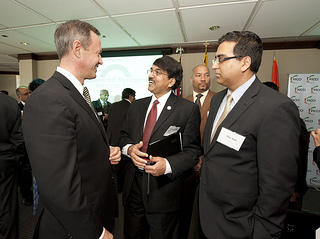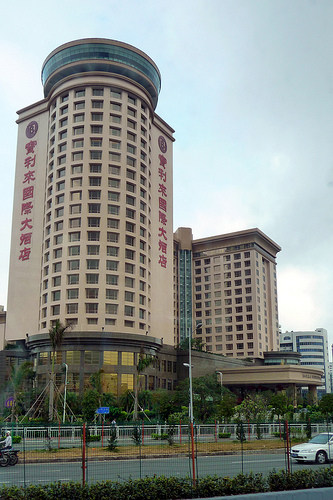Brazil, Russia, India and China. These four countries comprise more than 2.8 billion people, 40% of the world’s population, and cover more than one-fourth of the world’s land area—not to mention, they account for more than 25% of the global GDP. No wonder business travel is booming in these nations and it doesn’t appear to be slowing down anytime soon. According to the Global Business Travel Association (GBTA), growth in business travel spending in the BRIC nations is projected to grow 2-3 times faster than in developed economies like the U.S., France, and Germany. With all of this talk about the ‘big four,’ we thought it would be fun to explore some emerging business travel trends for each of the BRIC countries. Read on.
Brazil
 Brazil’s business travel industry is currently ranked eighth in the world and is forecasted to surpass Italy, France and the U.K. over the next two years.
Brazil’s business travel industry is currently ranked eighth in the world and is forecasted to surpass Italy, France and the U.K. over the next two years.- Demand for hotel rooms and flights to Brazil have significantly increased with the upcoming World Cup in 2014 and the Summer Olympics in 2016.
- American Airlines now flies to seven Brazilian cities and offers over 100 flights to Brazil on a weekly basis (more than other airline carrier); they also plan to begin new service between Los Angeles and Sao Paulo in late 2013 and Chicago O’Hare and Sao Paulo in late 2014.
- An Open Skies agreement between the U.S. and Brazilian governments are set to take effect in October 2015. When this happens, airlines from the U.S. and Brazil will be allowed to select routes, destinations and prices for services based on consumer demand and market conditions.
- The President of Brazil, who believes airports are necessary for continued economic growth, has announced plans to build at least 800 new regional airports in the country. The ultimate plan is for all 194 million residents of Brazil to have access to air travel.
Russia
-

The GBTA’s Global Business Travel Spending Outlook 2011-2015 Study forecasts that business travel spend in Russia will increase by 7.1%.
- Demand for hotels and flights to Russia are expected to increase with the 2014 Winter Olympics and the 2018 FIFA World Cup.
- According to KPMG’s latest report, the number of international-brand hotel rooms in Russia is expected to double from 21,885 in October 2012 to 47,534 by 2018; more than eight new international brand hotels opened in 2012 and 27 announced to open.
- Moscow and St. Petersburg are Russia’s key business and tourism centers; however, other cities like Sochi (where the 2014 Winter Olympics are scheduled to be held) are expanding their hotel infrastructure as well.
- International air service to Russia has increased, but Aeroflot is still the only airline to provide nonstop service to Moscow.
India
 India continues to have the fastest growing economy in the world after China (about 6% a year).
India continues to have the fastest growing economy in the world after China (about 6% a year).- According to Ernst and Young, India’s middle class is steadily growing—currently it stands at around 50 million people, or 5% of the population, and it is expected to reach 200 million by 2020.
- Getting air and hotel accommodations in first-tier cities like Mumbai, Delhi and Bangalore is not difficult, but for 2nd-tier cities like Hyderabad, travelers are forced to rely on the local sectors.
- With the growth of new meeting spaces around India, like the Ashok in New Delhi, meeting planners are now looking at India as a potential convention destination.
- Travel and tourism’s contribution to India’s GDP was 7% in 2012—if obtaining a visa were easier this number would probably be higher.
China
 According to the GBTA, if current growth rates continue, China could become the top business travel market in the world as early as 2015.”
According to the GBTA, if current growth rates continue, China could become the top business travel market in the world as early as 2015.”- To accommodate all these travelers, the Civil Aviation Administration of China (CAAC) says that China plans to build 70 new airports in the next few years and to expand 100 existing airports.
- In addition to this, Beijing is in the midst of constructing a second airport, which is expected to be finished December 2018. The construction will cost at least 70 billion dollars and is expected to have the capacity to handle 75 million passengers by 2025.
- Ernst and Young predicts that as many as 500 million Chinese could enter the global middle class over the next decade; by 2030 70% of China’s population could be middle class (which means major business opportunities).
- China’s hotel industry only began to grow after diplomatic relations were established between the U.S. and China back in 1979—back then, there were a mere 137 hotels in all of China; now, according to a report issued by InterContinental Hotels Group (IHG), it’s estimated that China will have 6.1 million hotel rooms by 2025 (reaching parity with the U.S.).
Have you traveled to one of the BRIC countries for business or will you be in the near future? Let us know in the comments below—we’d love to hear from you!
Safe Travels!
Photo Credits
Cathedral of Christ the Saviour, Moscow by Arian Zwegers
Arrival of President of Brazil from President of the European Council
India Business Forum from Maryland Government Pics
Baolilai International Hotel Shenzhen China by DC Master (Chris)


